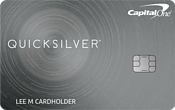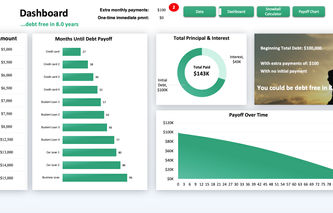| Name | Score | Visit | Annual Fee | Regular APR | Intro Offer | Credit Needed | Disclaimer | |
|---|---|---|---|---|---|---|---|---|
.svg) | 7.0 | Visitcapitalone.com | $0 | 30.74% (Variable) | N/A | Fair (580–689) | ||
 | 9.6 | Visitcapitalone.com | $0 | 19.99% - 29.99% (Variable) | One-time $200 cash bonus | Good–Excellent (690–850) |
Capital One Platinum vs. Quicksilver—which is the Capital One card for you? The choice may be simpler than you think.
Why is that?
Because it’ll mostly depend on your credit score.
This article will show you:
How the two cards compare.
What we like about them.
The alternatives for both.
Read more:
Capital One Platinum Card Review
Capital One SavorOne vs. Quicksilver
Capital One Quicksilver Review
Capital One QuicksilverOne Review
Capital One Venture vs. Quicksilver
Capital One Platinum vs. Quicksilver—Credit Cards Overview
Platinum and are two credit cards offered by Capital One, each catering to different financial needs and preferences.
Here’s a brief comparison of their features:
CAPITAL ONE PLATINUM | CAPITAL ONE QUICKSILVER | |
Card image |  |  |
Best for | Building credit | Rewards |
Required credit score | Fair/limited credit history | Good to excellent |
Intro offer | N/A | $200 for spending $500 in the first three months |
Intro APR | N/A | 0% for the first 15 months |
APR | 29.99% | 19.74%–29.74% variable APR after the intro period |
Rewards | N/A | 1.5%–5% |
Annual fee | $0 | $0 |
Further info |
Who they’re for
Platinum: Great for folks with average credit who want to improve their credit score.
Quicksilver: Perfect for those with good to excellent credit who love earning cash back on their purchases.
Rewards
Platinum: No rewards here, but it’s all about building credit, right?
Quicksilver: You’ll get 1.5% cash back on every purchase daily—a pretty sweet deal.
Annual fee
Platinum: No annual fee, so you can focus on improving your credit without extra costs.
Quicksilver: Also, no annual fee means more cash back in your pocket.
Introductory offers
Platinum: None—but remember, it’s all about building your credit.
Quicksilver: You can enjoy a 0% intro APR on purchases and balance transfers for the first 15 months. After that, it’s a variable APR based on your creditworthiness.
Still have questions?
Let’s take a closer look at Quicksilver and Platinum cards individually:
Capital One Platinum card overview
CATEGORY | FEATURES | RATING |
|---|---|---|
APR | 29.99% | 1/5 |
Annual fee | $0 | 5/5 |
Intro offer | $0 | 3/5 |
Rewards | 0.00% | 3/5 |
Overall credit card rating | 3/5 |
The is a great option for those with average or fair credit who want to step up their credit game without the hassle of annual fees.
Here are its main features:
Credit-building buddy
This card is perfect for people with average credit who want to boost their credit score. Use the card responsibly and make your payments on time, and you’ll be on your way to a better credit history.
No security deposit
If you’ve ever looked for ways to build a good credit score, you already know this—secured credit cards are your go-to.
But there are unsecured credit cards that will let you boost your score without depositing money upfront—and yes, the Capital One Platinum is one of them.
To cover all the bases here, if you prefer to make a deposit and earn rewards (as you’ll see, the Platinum card doesn’t offer them), you can choose the credit card.
No annual or foreign transaction fees
You don’t have to worry about yearly fees with the Capital One Platinum card. That’s one less expense to think about.
Fraud coverage
Capital One has your back with their $0 Fraud Liability policy if your card is ever lost or stolen. You won’t be on the hook for any unauthorized charges.
CreditWise
Watch your credit progress with Capital One’s free CreditWise tool. It helps you monitor your credit score and gives you tips on how to improve it.
Account alerts and autopay
Stay on top of your finances with customizable account alerts and autopay options. You can set up reminders for due dates, payment postings, and more.
Access to a higher credit line
Capital One may reward you with a higher credit line if you make your first six monthly payments on time. That’s a nice bonus for being responsible with your card.
As Michael Diamond, Financial Literacy Expert at MDFinancial Skills, says:
Boosting your credit score might prove difficult because it seems like such an abstract goal, but a credit card that offers rewards for on-time payments will motivate you to stay on track.
Platinum is the best Capital One credit card for building credit without a security deposit.
Capital One Platinum card—pros & cons
Pros
- Good for building credit.
- Relatively low entry barrier.
- No annual fee.
- No foreign transaction fee.
- Possible credit limit increase after six consecutive on-time payments.
- No hard inquiry when applying for the card.
- Access to CreditWise to monitor credit score and boost it.
- 24-hour travel assistance services.
- Fraud coverage and alerts.
Cons
- High interest rate.
- No cash back or rewards program.
- No intro offer.
Capital One Quicksilver card overview
 | |
APR | 19.99% - 29.99% (Variable) |
Annual fee | $0 |
Intro offer | One-time $200 cash bonus |
Rewards | 1.5% on every purchase 5% for car rentals and hotels booked through Capital One Travel |
Overall credit card rating | 4.8/5 |
Learn more
The Capital One Quicksilver card is a popular Capital One rewards card designed for those with good to excellent credit.
It offers a straightforward rewards structure, making it an attractive option for those who want to earn cash back without the hassle of tracking categories or spending limits.
Here’s a quick overview of its features:
Cash back rewards
With the Quicksilver card, you’ll earn a flat 1.5% cash back on every purchase. There are no rotating categories or spending caps to worry about, so you can enjoy hassle-free rewards.
On top of that, you can earn 5% on hotels and rental cars booked using the Capital One Travel account.
Sign-up bonus
As a new cardholder, you can earn a one-time $200 cash bonus if you spend $500 on purchases within the first three months from account opening.
Intro APR
The card offers a 0% intro APR on purchases and balance transfers for the first 15 months. After that, there’s a variable APR based on your creditworthiness.
No annual fee
The Quicksilver card has no annual fee, which means you can maximize your cash back earnings without worrying about offsetting costs.
Additional benefits
The card comes with a few extra perks, such as extended warranty protection, travel accident insurance, Uber One membership, and 24/7 access to Capital One’s customer service.
Foreign transaction fees
Good news for travelers—the Quicksilver card has no foreign transaction fees, making it a convenient option for international spending.
The Capital One Quicksilver card is an excellent choice for those who want a simple, no-fuss cash back rewards program with no annual fee and a few additional benefits.
Related articles:
Capital One Quicksilver card—pros & cons
Pros
- Generous rewards program if you use the Capital One Travel.
- Bonus offer.
- Intro offer.
- Benefits like Uber One membership.
- No hard inquiry when applying for the card.
Cons
- High entry barrier.
- 5% cash back is available only to those who travel a lot.
- High APR after the intro period.
This is one of the best Capital One credit cards for earning rewards for those with excellent credit scores, with a $0 annual fee.
Capital One Credit Cards Comparison—Platinum vs. Quicksilver
Fees & rates
FEES | ||
|---|---|---|
Annual fee | $0 | $0 |
Intro APR | N/A | 0% intro APR for 15 months |
APR | 29.99% | 19.74%–29.74% variable APR after the intro period |
APR for cash advances | 29.99% | 29.74% |
Balance transfer fee | 3% | 3% during the intro 0% APR time period; no fee when transferred after the 15-month intro period |
Cash advance fee | Either $3 or 3% of the amount of each cash advance (whichever is greater) | Either $3 or 3% of the amount of each cash advance (whichever is greater) |
Foreign transaction fee | 0% | 0% |
Late fee | Up to $40 | Up to $40 |
Both cards have no annual fee, which is great for those who want to use the card to earn rewards without worrying about accumulating any costs.
When it comes to APR, the Platinum card has a fixed rate of 29.99%, while the Quicksilver card offers a 0% intro APR for the first 15 months, followed by a variable APR ranging from 19.74% to 29.74% based on your creditworthiness.
The cards score pretty much the same for cash advances and the APR for cash advances.
As for balance transfers, Capital One Platinum charges a consistent 3% fee.
The Quicksilver card charges 3% for the first 15 months during its 0% APR intro period. After that, there is no transfer fee—but you’ll be paying the standard APR on each transferred balance. So the Quicksilver card is, hands-down, a winner for balance transfers.
Capital One rewards
REWARDS | PLATINUM | QUICKSILVER |
|---|---|---|
Rewards program | No | Yes |
Rewards rate | N/A | 1.5%–5% |
Rewards details | N/A | Unlimited 1.5% cash back on every purchase and unlimited 5% cash back on rental cars and hotels booked using Capital One Travel |
Rewards redemption | N/A | You can redeem your rewards as cash, gift card, or just to cover your recent purchase |
The Capital One Quicksilver card is the clear winner when it comes to rewards, offering cash back on purchases and travel bookings.
The Platinum card focuses on helping cardholders build (or rebuild) their credit without a rewards program.
Capital One Platinum vs. Quicksilver—Approval Rate
For obvious reasons, the Platinum card has bigger approval rates (it’s much easier to get).
But there are many Capital One cards to choose from, so we’ll compare a few of the most popular ones before you apply—
Capital One Cards Comparison—Quicksilver vs. Platinum vs. QuicksilverOne vs. VentureOne Rewards vs. SavorOne
THE BEST CAPITAL ONE CARDS | PLATINUM | QUICKSILVER | QUICKSILVERONE | VENTUREONE | SAVORONE |
|---|---|---|---|---|---|
Best for | Building credit | Rewards | Rewards and building credit | Traveling | Rewards |
Required credit score | Fair | Excellent | Fair | Excellent | Excellent |
Annual fee | $0 | $0 | $39 | $0 | $0 |
Intro APR | N/A | 0% for the first 15 months | N/A | 0% intro APR for 18 months | 0% for the first 15 months |
APR | 29.99% | 19.74%, 25.74% or 29.74%, based on your creditworthiness (after the intro period) | 29.99% | 19.74%–29.74% after the intro period | 19.74%–29.74% after the intro period |
Rewards | N/A | 1.5%–5% | 1.5%–5% | 1.25–5 points per dollar spent | 1%–10% |
Intro offer | N/A | $200 | None | 40,000 bonus miles after spending $1,000 in the first 3 months | $200 |
Alternatives for the Capital One Platinum Card
QuicksilverOne from Capital One
The QuicksilverOne Rewards card is a good option for those with average credit who want to earn cash back while improving their credit score, but it comes with a $39 annual fee.
See the table below for Capital One cards comparison:
THE BEST CAPITAL ONE CARDS | PLATINUM | QUICKSILVERONE |
|---|---|---|
Best for | Building credit | Rewards and building credit |
Required credit score | Fair | Fair |
Annual fee | $0 | $39 |
APR | 29.99% | 29.99% |
Rewards | N/A | 1.5%–5% |
Intro offer | None | None |
Quicksilver Secured
The card (mentioned earlier) is a secured version of the Capital One Platinum.
It requires a refundable security deposit of $200—but you earn 1.5% cash back on every purchase.
THE BEST CAPITAL ONE CARDS | PLATINUM | QUICKSILVER SECURED |
|---|---|---|
Best for | Building credit | Rewards and building credit |
Required credit score | Fair | Fair |
Annual fee | $0 | $0 |
APR | 29.99% | 29.99% |
Rewards | N/A | 1.5%–5% |
Intro offer | None | None |
So, if you can splurge on the deposit, the secured card would make you some change. It’s good for boosting credit, too.
Alternatives for the Capital One Quicksilver Card
Chase Freedom Unlimited®
The Capital One Quicksilver Card and Chase Freedom Unlimited® are both cash back credit cards—they offer similar rewards structures but have some differences in terms of additional benefits.
Chase Freedom Unlimited® offers 5% cash back on travel purchased through Chase Ultimate Rewards, 3% cash back on dining and drugstore purchases, and 1.5% cash back on all other purchases.
New cardholders can earn a $200 bonus if they spend $500 in the first three months.
It also has additional benefits—like purchase protection and extended warranty protection.
THE BEST CAPITAL ONE CARDS | QUICKSILVER | CHASE FREEDOM UNLIMITED |
|---|---|---|
Best for | Rewards & travel | Rewards |
Required credit score | Excellent | |
Annual fee | $0 | $0 |
Intro APR | 0% for the first 15 months | 0% for the first 15 months |
APR | 19.74%, 25.74% or 29.74%, based on your creditworthiness after the intro period | 19.74%–28.49% after the intro period |
Rewards | 1.5%–5% | 1.5%–5% |
Intro offer | $200 | $200 |
Both cards offer attractive cash back rewards, but the Chase Freedom Unlimited® has a tiered rewards structure with higher cash back rates in specific categories.
The Capital One Quicksilver Card offers a simpler flat-rate cash back structure and has no foreign transaction fees, so it’s a better option for international spending.
VentureOne Rewards from Capital One
The Capital One Quicksilver card and the VentureOne Rewards from Capital One are both credit cards designed for those with good to excellent credit.
But they cater to different preferences—with the Quicksilver focusing on cash back rewards and the VentureOne targeting travel rewards.
THE BEST CAPITAL ONE CARDS | QUICKSILVER | VENTUREONE |
|---|---|---|
Best for | Rewards & travel | Traveling |
Required credit score | Excellent | Excellent |
Annual fee | $0 | $0 |
Intro APR | 0% for the first 15 months | 0% for the first 18 months |
APR | 19.74%, 25.74% or 29.74%, based on your creditworthiness after the intro period | 19.74%–29.74% after the intro period |
Rewards | 1.5%–5% | 1.25–5 points per dollar spent |
Intro offer | $200 | 40,000 bonus miles after spending $1,000 in the first 3 months |
The VentureOne Rewards card offers 1.25 miles per dollar on every purchase.
New cardholders can earn a one-time bonus of 20,000 miles after spending $500 on purchases within the first 3 months from account opening (equal to $200 in travel).
There are some additional travel benefits like travel accident insurance and 24-hour travel assistance services.
The VentureOne Rewards card has no foreign transaction fee, and it offers miles that can be redeemed for travel expenses so it’s a perfect choice for those who travel a lot.
SavorOne Rewards from Capital One
Now let’s compare the Capital One Quicksilver Card and the SavorOne Rewards.
THE BEST CAPITAL ONE CARDS | QUICKSILVER | SAVORONE |
|---|---|---|
Best for | Rewards & travel | Rewards |
Required credit score | Excellent | Excellent |
Annual fee | $0 | $0 |
Intro APR | 0% for the first 15 months | 0% for the first 15 months |
APR | 19.74%, 25.74% or 29.74%, based on your creditworthiness | 19.74%–29.74% |
Rewards | 1.5%–5% | 1%–10% |
Intro offer | $200 | $200 |
SavorOne Rewards card seems to be a better option with its generous cash back on dining, entertainment, and groceries. (Or is it just the Joey Tribbiani in us talking?)
Both cards have no annual fee and no foreign transaction fees, making them good options for traveling.
Want more? Check out the best cashback cards.
Quicksilver vs. Platinum—Which Capital One Card to Choose?
Choose the Capital One Platinum if:
You have no more than a fair credit score.
You want to build credit.
You’re not yet able to get a rewards credit card.
If that’s you, you can apply here.
Choose the Capital One Quicksilver if:
You have an excellent credit score and you want to easily get cash back for your purchases.
You use Capital One Travel either way so you just might take advantage of the 5% cash back offer.
You weren’t approved for rewards credit cards that are better than Quicksilver.
Ready to apply? .

.jpg)




